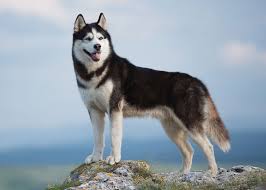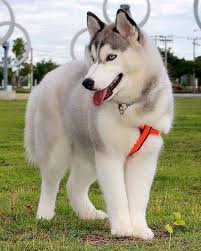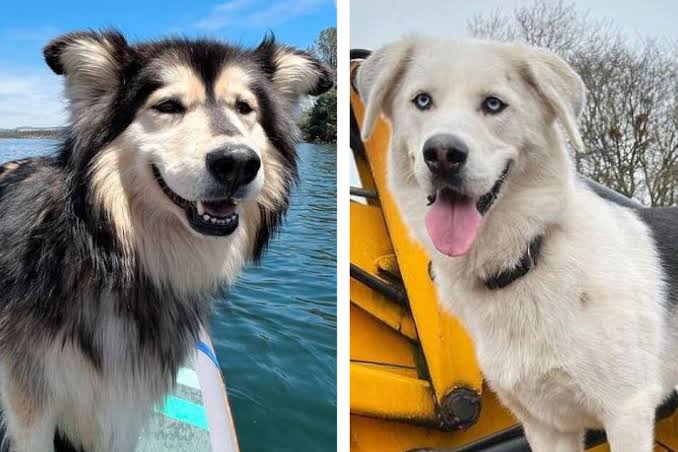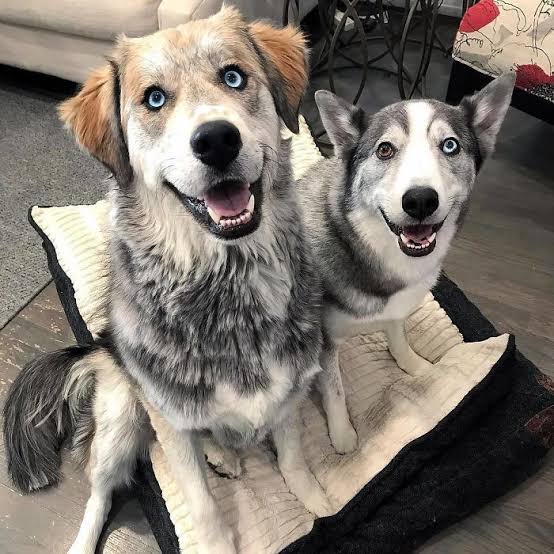A dog husky is a domesticated dog breed that is known for its thick fur coat, high energy levels, and intelligence. Huskies are a type of sled dog that were originally bred in the Arctic regions for use in pulling sleds and other heavy loads over long distances.
Huskies are typically medium to large-sized dogs, with males weighing between 45-60 pounds and females weighing between 35-50 pounds. They have distinctive features such as their pointed ears, thick double coat, and a curled tail.
Huskies are highly intelligent dogs and can be trained for a variety of tasks, including sledding, racing, and search and rescue operations. They are also known for their friendly and sociable nature, and they make excellent family pets.
However, huskies require a lot of exercise and stimulation, so they may not be suitable for all households. Additionally, their thick fur coat requires regular grooming to prevent matting and to keep them clean and healthy.
The Husky is a medium to large-sized dog breed that has a distinctive appearance. Here are some key characteristics of a Husky’s appearance:
Thick fur coat: Huskies have a thick, double-layered fur coat that helps protect them from cold weather. The outer coat is long and coarse, while the inner coat is soft and dense.
Pointed ears: Huskies have pointed ears that stand erect, which gives them a wolf-like appearance.
Bright blue or brown eyes: Many Huskies have striking blue or brown eyes that are very expressive.
Athletic build: Huskies are known for their lean, athletic build, which makes them excellent runners and sled dogs. They have a deep chest, muscular legs, and a long, thick tail that curls over their back.
Coloration: Huskies can come in a variety of colors, including black, white, gray, red, and brown. They often have distinctive markings on their face and legs.
Additionally, the Husky is a beautiful and striking dog breed that stands out for its thick fur coat, pointed ears, and athletic build.
Read Also: Methods of Fish Age and Growth Studies
History and Origin of The Husky Dog Breed

The husky dog is believed to have originated in the Arctic region, where they were originally bred by the Chukchi people. These people used huskies for hunting and transportation, relying on their strength and endurance to help them survive in the harsh Arctic environment.
One of the interesting things about the history of the husky dog is that they are actually a relatively new breed. While dogs have been used for transportation and hunting for thousands of years, the husky as we know it today was only developed within the last few hundred years.
As the Chukchi people began to trade with outsiders and travel to other areas, they started to crossbreed their huskies with other dog breeds, such as the Siberian husky and Alaskan Malamute. These crossbreeds helped to create the modern-day husky, which is known for its distinctive appearance and friendly personality.
One of the unique features of the husky is their thick fur coat, which helps to keep them warm in the Arctic environment. In fact, their fur is so thick that it can insulate them against temperatures as low as -60 degrees Fahrenheit! But while their fur is perfect for surviving in the cold, it can also require a lot of maintenance to keep it clean and healthy.
Another interesting fact about the husky is that they are highly intelligent and trainable. This has made them a popular breed for a variety of tasks, including search and rescue operations, sled racing, and even therapy work.
Overall, the husky dog has a rich history and a fascinating origin story. From their beginnings as sled dogs in the Arctic to their modern-day role as beloved pets, these furry friends have come a long way. So the next time you see a husky out for a walk, take a moment to appreciate their unique history and all that they have to offer.
Health Issues and Lifespan of The Husky Dogs
Hip dysplasia: This is a genetic condition where the hip joint does not develop properly, leading to pain and discomfort. Huskies can be prone to hip dysplasia, so it’s important to have them screened for this condition if you plan to breed or adopt a Husky.
Eye problems: Huskies can be prone to eye problems such as cataracts, progressive retinal atrophy, and corneal dystrophy. These conditions can cause vision loss or blindness, so it’s important to have your Husky’s eyes checked regularly by a veterinarian.
Skin conditions: Huskies can develop a variety of skin conditions such as dermatitis, allergies, and hot spots. These conditions can cause itching, redness, and discomfort, so it’s important to keep your Husky’s skin clean and healthy.
Gastric torsion: Also known as bloat, this is a serious condition where the stomach twists and becomes filled with gas. This can be life-threatening if not treated promptly, so it’s important to recognize the signs of bloat and seek veterinary care immediately.
The average lifespan of a Husky is between 12-15 years, which is relatively long for a medium to large-sized dog breed. However, like all dogs, their lifespan can be affected by factors such as diet, exercise, and healthcare.
To help your Husky live a long and healthy life, it’s important to provide them with regular veterinary care, a healthy diet, and plenty of exercise and mental stimulation. By taking good care of your Husky, you can help ensure that they stay healthy and happy for many years to come.
The Husky Dog Breed Complete Grooming and Care Guide
Brushing: Huskies have a thick, double-layered fur coat that requires regular brushing to prevent matting and shedding. Brushing at least once a week with a slicker brush or undercoat rake can help remove loose fur and prevent tangles.
Bathing: Huskies should be bathed as needed, typically every 2-3 months, to keep their coat clean and healthy. Use a gentle shampoo formulated for dogs and rinse thoroughly to prevent skin irritation.
Nail trimming: Regular nail trimming is important to prevent overgrowth and discomfort. Trim your Husky’s nails every 2-3 weeks, being careful not to cut too close to the quick.
Teeth cleaning: Dental care is important for Huskies, as they can be prone to dental problems such as tartar buildup and gum disease. Brush your Husky’s teeth regularly with a dog-specific toothbrush and toothpaste, or offer dental chews and treats.
Exercise: Huskies are a high-energy breed that requires plenty of exercise and mental stimulation to stay healthy and happy. Aim for at least 1-2 hours of exercise per day, such as walks, runs, or playtime in a fenced yard.
Training: Huskies are intelligent and trainable, but they can be independent and stubborn at times. Consistent and positive training methods can help prevent behavioral problems and encourage good behavior.
Health care: Regular veterinary care, including vaccinations, check-ups, and parasite prevention, is important to keep your Husky healthy and free from illness.
By following these grooming and care tips, you can help your Husky stay healthy and happy for many years to come. Remember to always provide plenty of love and attention, and enjoy the unique and wonderful personality of your furry friend.
Siberian Husky

The Siberian Husky is believed to have originated in northeastern Asia, where they were bred by the Chukchi people as working dogs. These dogs were used for transportation, hunting, and as family companions, and their endurance and cold-weather tolerance made them well-suited to life in the harsh Arctic climate.
In the early 1900s, Huskies were brought to Alaska for use in sled dog racing. These dogs quickly gained a reputation for their speed, endurance, and athleticism, and they soon became popular around the world as sled dogs and working dogs.
The Siberian Husky is a medium-sized dog, typically weighing between 35-60 pounds. They have a distinctive wolf-like appearance, with a thick double coat of fur that comes in a variety of colors such as black, white, gray, and red. Their eyes are one of their most striking features, and can be blue, brown, or green.
Siberian Huskies are known for their friendly and outgoing personalities. They love attention and affection from their humans, and enjoy spending time playing and exploring outdoors. These dogs are highly intelligent, but can be stubborn at times, which can make training a challenge.
Huskies are also very energetic and need plenty of exercise and mental stimulation to prevent boredom and destructive behavior. Regular walks, runs, and playtime in a fenced yard can all help keep your Husky happy and healthy.
Agouti Husky

The Agouti Husky’s coat can come in a variety of colors, including black, gray, and brown, and their eyes are typically brown or amber. They are medium-sized dogs, weighing between 35-60 pounds, and have a playful and energetic personality that is typical of the Husky breed.
Agouti Huskies have the same health and care requirements as other Huskies. They need plenty of exercise and mental stimulation to stay happy and healthy, and require regular grooming to keep their thick fur coat in good condition.
While Agouti Huskies are not as common as other variations of the breed, they are highly sought after by dog lovers who appreciate their unique and striking appearance. If you’re considering adding an Agouti Husky to your family, be prepared for a loyal and energetic companion who will steal your heart with their stunning good looks and playful personality.
Read Also: Definition and Forms of Fish Growth
Siberian Husky Puppies

When it comes to choosing a Siberian Husky puppy, there are a few things to keep in mind. It’s important to find a reputable breeder who has properly socialized the puppies and can provide you with information about their health and history.
It’s also important to consider the needs of a Husky puppy. These dogs are energetic and require plenty of exercise and mental stimulation to keep them happy and healthy. They also have a thick fur coat that requires regular grooming to prevent matting and shedding.
Once you bring your Siberian Husky puppy home, it’s important to begin socializing and training them right away. Huskies are intelligent dogs, but they can be stubborn at times, so consistent training and positive reinforcement are key to success.
Overall, Siberian Husky puppies are a joy to be around and make wonderful family pets for those who are willing to put in the time and effort to properly care for them. With their playful personalities and striking good looks, these puppies are sure to bring endless love and laughter into your life.
Golden Retriever Siberian Husky Puppy

These puppies are typically medium-sized, weighing between 45-90 pounds, and have a thick, plush fur coat that can come in a variety of colors, including gold, cream, brown, and black. Their eyes are typically blue or brown, and their personalities are friendly, playful, and intelligent.
Goberian puppies are energetic and require plenty of exercise and mental stimulation to stay happy and healthy. They also have a thick fur coat that requires regular grooming to prevent matting and shedding.
When it comes to training, Goberians are intelligent and eager to please, making them relatively easy to train with positive reinforcement and consistency.
If you’re considering adding a Goberian puppy to your family, it’s important to find a reputable breeder who has properly socialized the puppies and can provide you with information about their health and history.
Overall, a Golden Retriever Siberian Husky puppy is a wonderful choice for those who are looking for a loyal and affectionate companion with striking good looks and a playful personality.
